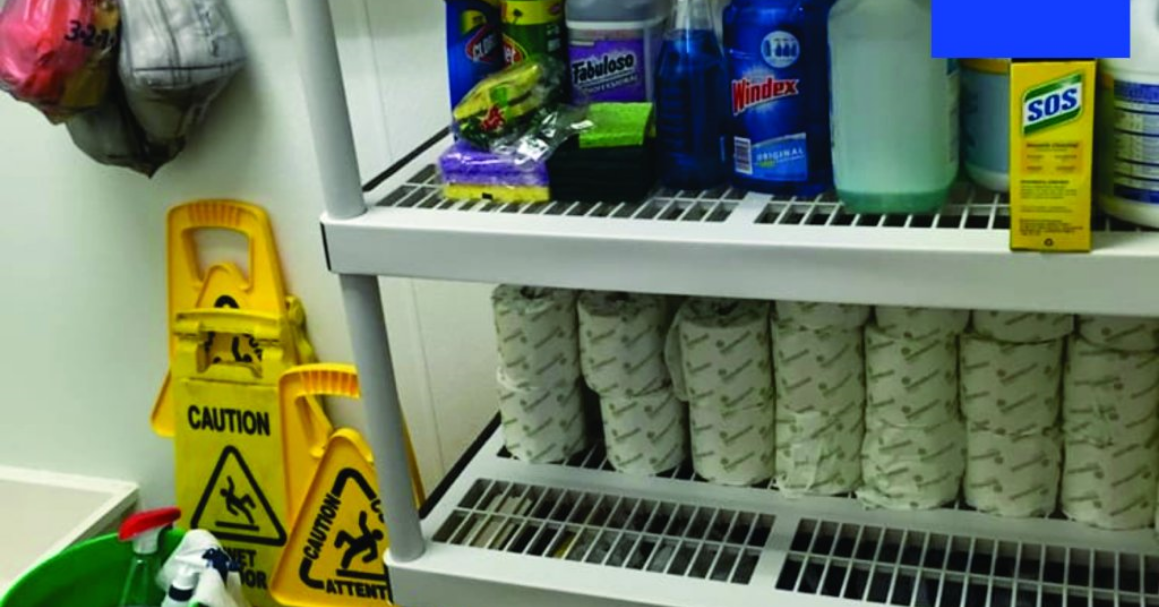
This article is the second in the series “The Ultimate Cleaning Guide” and in it I will discuss the cleaning closet, also known as “no man’s land” or if I am to be politically correct “no person’s land”. This is a place where everything collects, is usually never cleaned and nothing gets thrown out. Every time I take on a new client, my first job is always to clean, update and organize the cleaning closet (also known as the janitor’s closet). Whether it’s an actual room or shelf under the kitchen sink, it is usually a disorganized collection of dusty bottles and cleaning items that no one has looked at for a long time.
If you are cleaning your own premises or you’re asking a staff member to do it, it is a thankless task that you want to complete as quickly as possible. The cleaning closet is “out of sight and out of mind”. This means that no one goes there unless they have to and it is no one’s responsibility. Here are a few tips that, if followed, will make your life a lot easier.
The cleaning closet is not self-explanatory
Most people have no idea what product or chemical to use for a specific task. When you purchase a product for a specific purpose, don’t expect everyone to know just by the label what the product is used for. Forget the label and write on each bottle or container exactly what surface or purpose the product is used for. E.g. a bottle of disinfectant should have a specific purpose written on it – “for countertops and desks only” or “for bathroom floors only”. Don’t make anyone guess. Specify why the product exists and what you use it for.
Cleaning closets contain mystery items
Like everything else, cleaning products have a shelf life. I have found that in an office or commercial environment the cleaning closet (no man’s land) is nobody’s responsibility and therefore nobody disposes of old products. Therefore, it is not uncommon to find products that are a complete mystery to everyone. The problem starts when you purchase a product for a specific task (e.g. a carpet stain, a blocked drain or renovation cleanup, etc.). The product is then placed on a shelf in the cleaning closet and months later it becomes a mystery item. No one knows why it was purchased or what it should be used for.
Use it, then lose it!
If you purchase a product for a specific task, don’t hoard it or store it. If you do, it becomes a mystery item! Dispose of it properly. It is much more prudent to purchase it again when you need it rather than having it occupy space and become a mystery to everybody that looks at it in the future. No one will dispose of an item that they didn’t purchase unless they are told to. So, the stockpile just grows. The more “mystery” products that you have on the shelf, the greater the risk of somebody using them incorrectly. This also means that the cleaning closet quickly grows into a storage unit of useless items.
SDS (Safety Data Sheets)
SDS sheets contain information that nobody looks at. We provide SDS sheets for every chemical that we place in a cleaning closet and I can tell you from experience that nobody looks at them. However, you MUST have SDS sheets for every product that is on the shelf. If an accident or exposure occurs, you MUST have the SDS sheets readily available to explain how to treat the exposure. So, if you’re going to keep a product on the shelf, go to the manufacturer’s site and find the SDS sheet for it. PRINT the sheet and keep it either with the product or somewhere that everyone can find it. Finally, TELL your staff where to find the SDS sheets.
Protective items
If you or your staff are going to clean your premises then make sure that you have available; protective gloves, protective eye wear and masks. Even if you choose not to use them you need to provide them. Store them in the cleaning closet so that everyone is reminded to use the protective gear.
What to keep in the cleaning closet
The average cleaning closet only needs the following basic cleaning products:
· A neutral floor cleaner
· A disinfectant
· A general-purpose cleaner
· A toilet bowl cleaner
· A glass cleaner
· A neutral detergent
· A neutral hand soap
In addition to cleaning products you will need:
· A mop and bucket (covered in “Choosing the right mop and bucket”)
· A vacuum cleaner (covered in “Vacuuming – Not as simple as it sounds”)
· A broom and dustpan
· Protective gloves, eye wear and masks
· Sponges
· Microfiber cloths
· Spray bottles
· Trash bags
· Toilet paper and hand towels
Some businesses/premises will need other products but above is a simple list of items that should exist in most cleaning closets.
Avoid bleach! Use alternative products wherever possible.
In closing, please note that just because your clients don’t go into your cleaning closet it doesn’t mean that it shouldn’t be kept as clean as your office. Keep everything clean, tidy and labeled. Trust me, you’ll be glad that you do.
